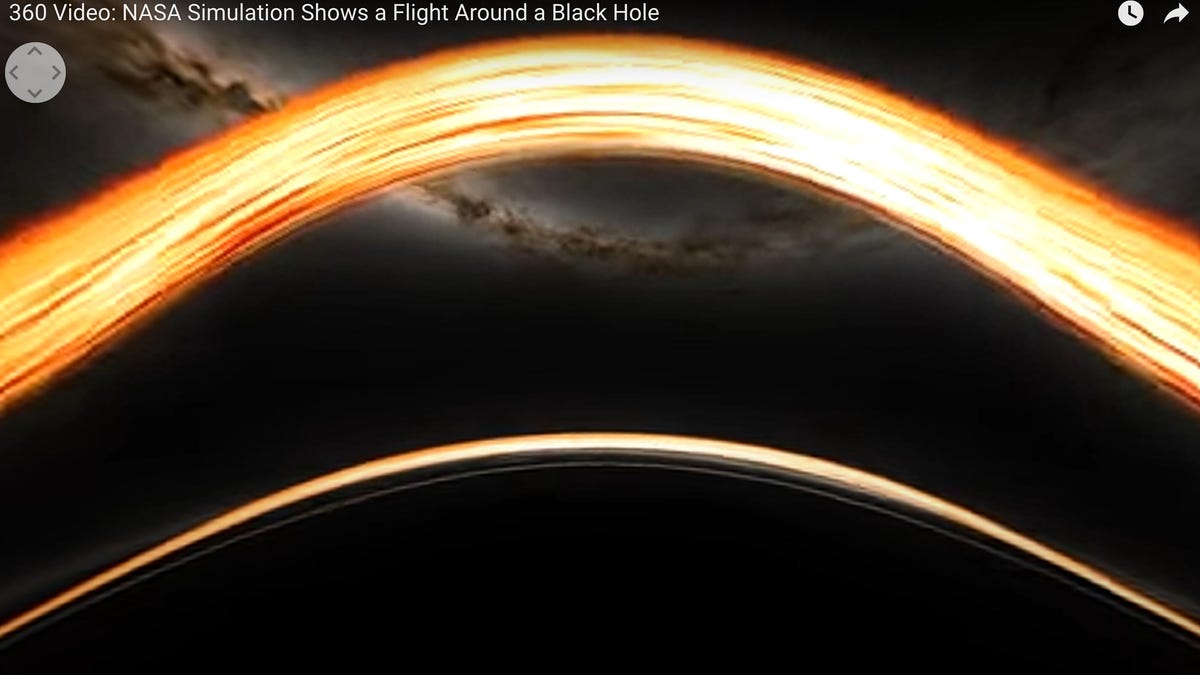
Black holes, those mysterious places in space where gravity is so strong that not even light can escape, make for great movie plot twists. But Hollywood aside, there are many things humans don’t understand about a black hole. A new video from NASA attempts to show what it looks like when an object crosses the event horizon, or boundary, of a black hole. Since no technology can survive this experience, this might be as close as we’re ever going to get.
The video, created by NASA’s Jeremy Schnittman and Brian Powell, begins with a camera view floating toward a black hole. As the camera approaches, it orbits around the black hole before the camera flies into the burning gas that surrounds it. It delivers a great view of some photon rings before entering the event horizon. From there, the camera experiences the stretching and distortion that’s colorfully known as spaghettification, as it’s pulled into the black hole. As the camera is sucked in, the simulated sky shrinks. Moments later, the camera goes dark as it hits the singularity, the one-dimensional center of a black hole, where the laws of physics cease to exist.
The simulation then plays again, but with explanations overlaid to explain each step of the process. The video then replays a third time, now in slow motion, and zoomed in to show the intricacies of the photon ring layers. It ends with a final replay of the whole simulation but this time with more technical details about how it was created. In all, the simulation is much more detailed than the images we have of the Milky Way’s black hole.
It’s quite the trip, and produces some truly striking images, especially those of the photon ring layers and the sky rapidly shrinking as the camera is pulled in.
Schnittman also made a second video with a simulation of the camera making a couple of orbits around the black hole before safely escaping. That one is a 360-degree YouTube video, allowing viewers to look around and see the entire trip from multiple angles.
The simulated black hole is enormous
The black hole in the simulation measures about 16 million miles (25 million kilometers) in diameter. That’s way bigger than Earth, and comparable to some black holes in our own cosmic backyard.
In case you, too, want to go flying into a black hole, Schnittman has some advice.
“If you have the choice, you want to fall into a supermassive black hole,” he said. “Stellar-mass black holes, which contain up to about 30 solar masses, possess much smaller event horizons and stronger tidal forces, which can rip apart approaching objects before they get to the horizon.”
In short, if you opted for a small black hole in this hypothetical situation, you might be torn to bits before you got to the good stuff. Supermassive black holes seem to be the way to go.
Thanks, NASA’s Discover supercomputer
The simulation was created using NASA’s Discover supercomputer, which is located at the NASA Center for Climate Simulation in Greenbelt, Maryland. The project generated approximately 10 terabytes of data, which NASA says is equivalent to roughly half the estimated text content in the Library of Congress.
It took about five days to complete and used just 0.3% of Discover’s 129,000 processors. NASA says the same work would’ve taken about a decade on a regular laptop.
Why work on such a huge and comprehensive simulation of a black hole? Schnittman says it’s mostly for research.
“People often ask about this, and simulating these difficult-to-imagine processes helps me connect the mathematics of relativity to actual consequences in the real universe,” Schnittman said in a post on NASA’s site. “So I simulated two different scenarios, one where a camera — a stand-in for a daring astronaut — just misses the event horizon and slingshots back out, and one where it crosses the boundary, sealing its fate.”


